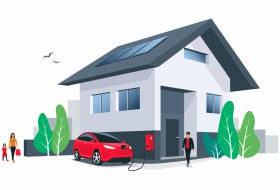Planning Application Guide
Live Application
This is normally the main part in the life of the application. Having been validated, the application file is allocated to a planning officer.
Applications should take eight weeks from the time they are registered to complete.
For Environmental Impact Assessment (EIA) the period is 16 weeks.
The case officer becomes familiar with the application and assesses issues that could be raised.
Contact with your Planning Officer
You will be notified electronically of the outcome at these key stages:
- Receipt
- Validation
- Decision
Should the officer require any further information this will be requested.
Please note that if an Agent has been appointed all correspondence will be sent to the Agent.
Planning officers calls and emailed are dealt with by the Planning Hwb.
Planning Hwb
The Planning Hwb receives, monitors and responds to all enquiries within 6 working days on behalf of the planning officers. This has resulted in improved response times for all parties and improved performance for determining planning applications. It is important to provide the Planning Hwb staff specific information on the information you require in order for a full response to be provided efficiently.
Planning Hwb can be contacted via email planninghwb@carmarthenshire.gov.uk or by telephone on 01267 228878.
The Planning Hwb will only correspond with the Agent if they have been appointed to an application.
We may contact the agent direct for more information on an application.
When an agent is appointed, all communication by the applicant must be via the agent and not direct to us.
We will also correspond with the Agents with at all key stages.
Should you wish to amend your application before its determined, you will need to provide us with amended plans. Please be mindful that submission of amendment plans will extend the consideration period. In addition, amendments to Major Planning Applications are subject to a fee.
Please ensure you provide your planning reference on all correspondence.
Publicity
All applications will be publicised as required by legislation.
Depending on the application type and size, we may consult using one or more of the following methods:
- A notification letter to neighbours /owners /occupiers with an adjoining boundary to the site
- A 'Planning Notice' displayed at or near the proposed site
- A press notice in the local newspaper
- All applications are published online on the Weekly List on our website.
A minimum of 3 weeks is allowed for publicity.
Your opinion matters
We want to hear your views so that we can take them into account when considering planning applications.
If you would like to comment on a proposed development, you must do so within the 21 day consultation period. Comments can be made by anyone, as long as they provide their personal details and can be objections, support, or observations about the application. We cannot accept comments from anyone who wishes to remain anonymous.
All comments, for and against, an application are considered if they raise material planning considerations, as these can be taken into account during the assessment process.
Due to the volume of correspondence that we receive, we will not acknowledge receipt of your comments or respond to the comments or questions submitted or inform you of the decision. You can track the progress of the planning application online including the decision notice.
When commenting on an application, please consider the following points:
- Be Clear – It is important to state which planning application your comments relate to, therefore include the reference number, site address and description in your response
- Be Factual - All comments should be based on fact, and therefore, it is important that you view the plans for the proposed development before submitting your comments
- Relate to Planning – Only comments which relate to planning issues (known as “Material Considerations”) can be taken into account. If in doubt, it is better to put all your concerns down, and let the Case Officer work out which are material than to miss something out which could in fact be material.
- Relate to the Proposal - Only comments which relate to the relevant planning application can be taken into account
- Explain if and how it impacts on your property – Anyone can comment. However if you feel that a proposal will impact on your property, it is helpful to explain how (including the relationship between your property and the application site).
- Fully set out your concerns – Comments which simply indicate support or objection will normally carry little weight. It is therefore important that you clarify why you support or object to a proposal.
- Your information - Please be aware that anonymous submissions will not be considered. It is important to include your name, postal address and contact details (please note that if an email address is provided, we will assume that you are happy to receive further correspondence in that format)
All consultation responses are viewable by the public via the Public Register portal. You will need the planning application number to view the application.
You can submit your comments online, by email or in writing. When submitting comments, remember:
- Do not include personal information, other than your name and address in your comments.
- Your signature is not required if you’re submitting your comments online. If you include a signature on any letters to us, we will hide this when we publish it on our website.
- If commenting by email, send this as an attachment, this will ensure your email address is not published.
- You are responsible for any statements that you make. Please make sure that it is not offensive, harmful or untrue, if it is, your comment will be removed from the website.
- Any comments which are made will be published on our website, this may include your name and address.
- Anonymous comments will not be considered
All comments, for and against, an application are considered if they raise material planning considerations, as these can be taken into account during the assessment process. Along with your objections we must also consider local and national policy that may affect an application.
Due to the volume of correspondence that we receive, we will not acknowledge receipt of your comments or respond to the comments or questions submitted or inform you of the decision. You can track the progress of the planning application online including the decision notice.
Only the applicant can appeal against the decision but, if an appeal is made, you will be notified and will then have the opportunity of making further representations to the Government Planning Inspector dealing with the appeal.
If there are 3 or more objections from different households (householder and minor applications) and 7 or more objections from different households (major applications) AND the application is recommended for approval the application will be referred to the Planning Committee to determine.
The main parts of the planning application that are analysed are:
- Location of the development site
- The site's relationship with neighbouring properties
- Site specific and surrounding constraints such as:
- tree Preservation Orders (TPOs)
- conservation areas
- flood zones
- ecological areas
- Who has been consulted/notified
- Planning history of the site including:
- planning conditions
- reasons for previous refusals
- Application form details
- Ownership of the land
- Design and access statement
- Materials to be used
- Reports or statements made by the applicant
- Checks for accuracy of the plans
- Assessment of the plans
We will start to analyse any relevant issues we have identified.
We are only able to take account of material planning considerations. In considering an application, we have a statutory duty to have regard to the provisions of the development plan and any other “material considerations”.
The most common “material considerations” include the following, although the list is not exhaustive:
- overlooking/loss of privacy
- loss of light or overshadowing
- parking
- highway safety
- traffic
- noise
- affect on listed buildings and/or conservation areas
- layout and density of building
- design, appearance and materials
- nature conservation
- landscaping
Matters which cannot be taken into account are:
- private issues between neighbours e.g. land/boundary disputes, damage to property, private rights of way, covenants etc.
- loss of value of property
We will consider the responses received to see what comments have been made.
If we can see that a minor amendment would resolve problems or enhance the final build we may contact you or your agent to discuss the suggested changes.
Once the Consultation and publicity has been publicised, we will visit the site when appropriate and assess the impact of the application, taking into account planning policies and any responses we have received. During the visit the officer will note:
- Characteristics of the location including:
- terrain
- levels
- surrounding buildings
- the nature of the area
- Possible impacts on the neighbours including:
- loss of light
- overlooking
- compatibility of uses
- Visual impacts including:
- the effect on the street scene
- fit with the existing character
- Access
- Appropriate siting
- Environmental impacts such as:
- trees
- hedgerows
- flooding
- Local facilities
- Sustainability
Officers check that the relevant neighbours have been notified when required.
We generally ask applicants to put up the site notice where required. The display of site notices is the responsibility of the case officer during their site visit if:
- The applicant fails to post the site notice.
Not all types of application need site notices.
This part of the process pulls all the information together to help make a decision. The case officer researches the wide-ranging source materials. This research can include:
- histories of both the site and other similar cases
- local and national planning policies
- government guidance
- case specific research
- planning acts, regulations and case law
- design guides
- other supplementary planning documents
- consultation responses received
- a further site visit if necessary for clarification.
The officer then:
- gathers the information together and
- considers it beside the information learnt at the start of the process.
This provides the basis for a balanced recommendation that is fundamentally supported by planning policy. In exceptional cases the recommendation may be weighted to the contrary by other material considerations.
A case officer may, if considered appropriate, need to request:
- further information from the applicant or
- an amendment to the proposal.
The Planning Officer will make a decision on the proposal as quickly as possible within the statutory time limit or any other longer period as agreed in writing with the applicant.
The statutory time limit for a planning application are 8weeks for applications (unless an application is subject to an to an Environmental Impact Assessment, in which case a 16 week limit applies).
Once a decision has been made we will send out the decision notice to you or your agent. The notice will inform you if your application has been approved or refused.
If it has been approved it may have conditions attached to it. The conditions may restrict what you can do on the premises/land or if you need to obtain specific approval for aspects of the development, such as the materials to be used, before you can proceed. Some conditions will require you to submit further information via a Discharge of Planning Condition application for our approval before development starts.
If it has been refused it will contain the reasons as to why the proposal was unsuccessful.
A copy of the decision will be available on our website. You can track planning applications online and view associated documents and the decision notice.
Will my fee be refunded if my application is refused?
No. You are entitled to a resubmission without any further fee within one year of the date of a refused application or within one year of the date of receipt of a withdrawn application. The ‘free go’ resubmission must be by the same applicant, be for the same description of development, and relate to the same site as that for the initial application.
Application for a non-material amendment following a grant of planning permission
Town and Country Planning Act 1990 Section 96A
When this application is required
Following a grant of planning permission, it may be necessary to make amendments to the proposals that were originally approved. A non-material amendment may be applied for to approve a minor change to the planning permission and does not breach any conditions originally placed on the consent.
If we do not consider the amendment minor, a new planning application will be required.
Whether or not the proposed amendment(s) are considered to be ‘non-material’ rather than ‘material’ will depend on the specific details of the existing planning permission. A change which may be considered ‘non-material’ in one case could be considered ‘material’ in another. Judgements made on amendment(s) will be based off both the existing planning permission and any ‘non-material’ amendments which have previously been made.
Please note: This application type cannot be used to make changes to listed building consent.
Examples of changes which may be considered non-material:
Information Required
An application for a non-material amendment may require you to submit any changes to drawings and plans which were submitted under the original planning permission. As well as detailed information around the proposed amendments and how these differ from the original application.





